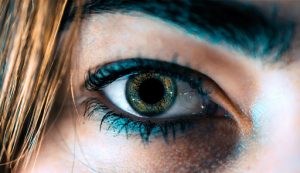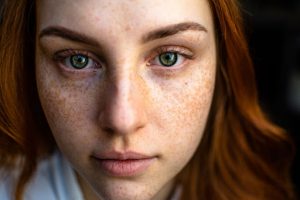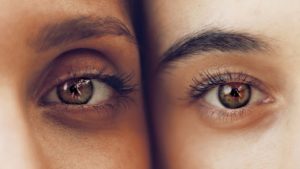-
Summer Savings: Save 20% On LASIK , Find More
*Must mention this promotion and be treated in August of 2024 to qualify. 20% off standard price of Wavelight procedure. Cannot be combined with any other offers.
Eye colors and their superpower and what’s the difference between them

Different Eye Colors and What They Mean
Whether you’re brown-eyed, blue-eyed (or a little bit of both), research suggests that some personality traits are actually associated with certain eye colors. Since no two people have exactly the same fingerprints, hair color, or teeth, it should come as no surprise that no one has the same exact eye color either.
It’s suggested that different eye colors have different meanings, and different characteristics attached to them. Today we’re looking at the different types of eye colors and explaining what it all means.
Keep reading for everything you ever wanted to know about eye colors!
What Determines Your Exact Eye Color?
The unique coloring of your iris is the result of a protective protein called melanin, which is present in your hair, skin and eyes.
Without any melanin, your iris actually has a bluish tint to it- which is why most babies are born with blue eyes. Melanin starts developing in the eye as you grow, for up to about 6 months after you’re born.
Your specific eye color depends on the amount of pigment present on the two surfaces of your iris. People with dark brown eyes have more melanin on the back layer of their iris, and eyes with very little (or no) melanin on the front layer of the iris appear more blue, green, or even hazel.
Usually eye color is determined by genetic traits, which are handed down from your parents. However, sometimes a genetic variation will alter the eye color, resulting in two blue-eyed parents having a brown-eyed baby, or vice versa!
Why Are There Different Eye Colors?
As we just mentioned, your eye color is the direct result of melanin present in your iris; more melanin = a darker iris. However, since melanin is a dark brown pigment, it begs the question: what causes green, blue or grey eyes?
Eyes with a higher concentration of melanin absorb more light, so less light is reflected back- resulting in a dark brown iris. With lower concentrations of melanin, less light is absorbed, so more is reflected back- resulting in a green, blue or hazel color.
If there is absolutely no melanin in the iris, it appears pink- as is seen in cases of albinism. (This is not to be confused with pink eye; if you’re experiencing this common eye infection, contact your doctor ASAP!)
According to the AAO, melanin may also protect the eye from some health conditions- but not others. For example, individuals with brown eyes supposedly carry a lower risk of eye cancer, diabetic retinopathy and macular degeneration but a higher risk of cataracts, as opposed to people with lighter eyes.
Melanin’s job is to protect your skin and eyes from harmful UV rays, so if you have light colored eyes, you should make a habit out of wearing protective glasses with UV protection when you’re outside or exposed to the elements.
Diving Into the Different Eye Colors
Millions of songs, poems and stories have been written about the most expressive of our human features, the eyes.
Even though science can’t quite give us a clear answer as to why this is, many people believe that eye colors are intrinsically linked to personality and attitude. Here are some common beliefs for what your eye color says about you:

Green Eyes
Green eyes are the result of something called Rayleigh scattering, which is used to describe the way light scatters after riding its spectrum wavelength.
Are people always commenting on your eye color? Part of the appeal of your beautiful green eyes might be their rarity. Interestingly enough, only about 2% of the world’s population has green eyes! If you have green eyes, people tend to assume that you are curious, passionate and creative.
If you have green eyes, make sure to protect your eyes outside and wear sunglasses or a hat!

Blue Eyes
What doesn’t kill you makes you stronger, and apparently more prone to having blue eyes. A recent study found that women with lighter eyes were more able to handle pain than their brown-eyed counterparts.
And, no: contrary to some popular wive’s tales, people with blue eyes are not all related.
Because people with blue eyes might be slightly more at risk of damaging their retinas from the UV light, most eye doctors recommend that blue-eyed folks wear sunglasses and protective eyewear when they’re outside in the sun.

Hazel Eyes
Only about 5% of the worldwide population has the hazel eye genetic mutation. Hazel eyes are usually a mix of colors- most commonly green and brown. Some say they’re “hazelnut” and others call them “golden” or even “brownish green.”
As with blue and green eyes, hazel eyes may appear to shift colors depending on the lighting, and even mood! People with hazel eyes are thought to be kind-hearted, curious and spontaneous.

Brown Eyes
Brown is the most common eye color- with nearly 55% people in the entire world having brown eyes- but that doesn’t make them any less special! Heck, one of the most famous Van Morrison songs is all about this particular eye color.
One study discovered that when people looked at pictures of people with brown eyes and then at people with blue eyes, they rated the brown-eyed people as more trustworthy, especially at first glance.
People with brown eyes have more melanin present in their iris, which insulates connections between brain cells and can cause them to fire more rapidly than their light-eyed counterparts. If you have brown eyes, studies also show that you might be less likely to develop macular degeneration.

What is Heterochromia?
Heterochromia is a very rare condition where your eyes are two different colors. The term Heterochromia comes from the Greek words “hetero” which means different and “chroma” meaning color.
Heterochromia occurs when:
- one of your iris’ is a different color than the other (David Bowie!) or
- there’s a spot on your iris that’s an entirely different color
Rather than have one distinct eye color, people with central heterochromia have a different color near the border of their pupils. Central heterochromia is just one type of heterochromia, an umbrella term which simply refers to having different eye colors.
The other types of heterochromia are:
Complete Heterochromia
People with complete heterochromia have eyes that are completely different colors. For example, if one of your eyes is green and the other eye is brown, blue, or another color you have complete heterochromia.
Segmental Heterochromia
With segmental heterochromia, a larger part of your iris is affected. This can develop in both the eyes or in just one. Sectoral heterochromia is just like an irregular spot on the iris- it doesn’t create a ring around your pupil.
Heterochromia can be caused by the following:
- Iris Ectropion syndrome
- Eye injury
- Diabetes
- Glaucoma
- Posner-Schlossman syndrome
- Iris tumor
- Swelling of eye
- Pigment dispersion syndrome
If you were born with different eye colors, there’s no reason to be alarmed! But if you start to notice a change in your eye color, this could be the symptom of an underlying health issue and you should see your doctor as soon as possible.
Here’s a fun fact: Animals can experience heterochromia, as well! If you’re a dog lover, you’ve probably noticed Siberian huskies, Australian shepherds and border collies with two different-colored eyes. In addition to other domestic animals, dogs can also experience this interesting genetic phenomenon.
Before You Go…
One of the most common questions we hear is, “Will LASIK change my eye color?”
Not to worry, this is just another LASIK misconception! The LASIK vision correction procedure does not affect eye coloring. And not only will LASIK leave your unique eye coloring intact, but you’ll potentially be able to see your eye color better after the procedure.
To see if you’re a candidate for the quick and easy LASIK procedure, take the short LASIK self test now! If you have any questions, our knowledgeable staff would be happy to help!
If you’re looking for more eye facts, head over to these articles for additional information:
YOU MIGHT ALSO LIKE...
VISION CENTERS NEAR ME
Enter your zip code, city, or a doctor name below to find a vision center.
Find out if LASIK is right for you
Congratulations!
Your vision issues can most likely be corrected with a LASIK procedure. Schedule a free consultation today.
Answer 5 simple questions to see if you are a candidate
What is your age group?
Do you wear...
With corrective lenses, do you have...
Have you ever been told that you have astigmatism?
Have you ever been told that you have dry eyes?
Request an Information Kit
Learn about your surgeon, the latest advanced technology, procedures, options and benefits, financing options, and what to expect from your LASIKPlus experience.









